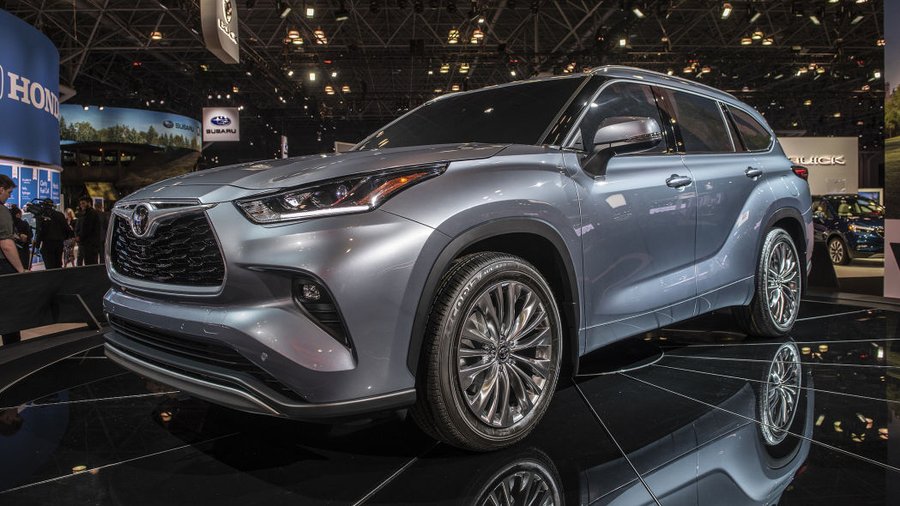5 questions answered about the 2020 Toyota Highlander

The 2020 Toyota Highlander has debuted at the New York Auto Show, and we've had our first look at what is largely an evolution of this highly successful mid-size, three-row crossover. Although checking it out in person answered some of our questions, we got a chance to interview the Highlander's chief engineer Yoshikazu Saeki about the rest.
Here are five questions we asked and had answered here in New York about the all-new Highlander.
Q: The new 2020 Highlander is only a bit bigger than the outgoing model, and remains one of the smallest three-row mid-size crossovers. Why hasn't it followed the size trend of most rivals?
A: According to Saeki, he had a choice of two directions with the new Highlander. He could have indeed made it bigger, matching many of its competitors, especially in terms of third-row and cargo space. Or, he could have maintained the smaller-than-average size it currently was. He obviously chose the latter. First, it was the size customers had come to expect. Would they be put off by something bigger? If customer loyalty has remained strong, it seems safe to deduce that the current size is right for many. Second, by maintaining that smaller-than-average size, the Highlander also maintains a point of differentiation with its competitors. After all, Saeki-san points out, the goal is to create vehicles that stand out and are different from everything else.
Q: Yoshikazu Saeki was chief engineer for both the 2019 Toyota RAV4 and the new Highlander, which utilize the same TNGA-K platform. Besides their obvious size differences, how are the two fundamentally different?
A: Saeki says that the goal of the RAV4 was also to create something different than the segment norm. However, in that case, it went in a completely new direction than the previous RAV4 to achieve it. He says he "deconstructed" the RAV4, moving from a more car-like direction to one that's sportier and/or more SUV-like. We go into that more in our 2019 Toyota RAV4 first drive.
By contrast, the new Highlander continues to have a strong emphasis on comfort, reduced NVH and a creating a premium feel. The goal was to instill a sense of safety and assurance with customers, 48 percent of which are female who mostly likely have family members riding with them. Something sportier and SUV-like are therefore not priorities. In that way, the new Highlander is indeed consistent with the segment norm, which certainly seems smart. Again, that smaller size is where the differentiation comes come.
Q: Unlike most new Toyotas, there are no sporty SE or XSE trim levels. Why?
A: Saeki thinks that the tuning of the Highlander is pretty much up to an SE trim level already. That largely comes from the TNGA-K platform. Just by using it, handling and the general fun-to-drive factor have inherently been improved, just as it has been in every Toyota that has utilized it. According to Saeki, it comes from a more linear throttle response (the current Highlander's is annoyingly delayed), as well as substantially improved structural and suspension stiffness. Steering tuning has also been improved, while a new Sport driving mode increases effort slightly as it does in the Avalon.
Honestly, the previous Highlander SE (pictured above) was about as mild of a sport trim level as you could get. It was almost just an appearance package. That Toyota chose not to offer a version for 2020 isn't surprising, but Saeki says that if the market starts to demand sportier entries in the segment, it would certainly be possible to do.
One should note that there isn't a RAV4 SE, either. There is an XSE Hybrid, but as Saeki explained to us during the RAV4 launch, that model was as much intended to help change the perception of hybrids. The RAV4 Hybrid is also the most powerful version, which is at least in keeping with a sporty entry. By contrast, the Highlander Hybrid has less power (240 horsepower) than the V6 version (295 hp).
Q: There's a RAV4 Adventure (pictured above). Will we see a Toyota Highlander Adventure?
A: Never say never, but for Saeki, the off-road-oriented Adventure trim was the ultimate expression of an overall attempt to make the RAV4 more SUV-like. Since that wasn't the goal with Highlander, it just didn't make sense to do so. We should also note that Toyota sells the 4Runner for pretty much the same people who might be interested in a more off-road-oriented mid-size SUV.
Q: It was announced that the Highlander Hybrid will achieve 34 mpg combined, versus the outgoing version's 28 or 29 mpg combined. Does that estimate apply to every 2020 Highlander Hybrid?
A: The 34 mpg combined estimate is for the front-wheel-drive Hybrid LE trim level. With all-wheel drive it goes down to 33 mpg combined. Upper trim levels will also lower it, but Saeki says not by much. We'd suspect a 1 mpg drop as was the case previously.
Nouvelles connexes


